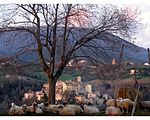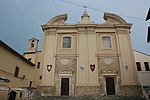Stimigliano
Cities and towns in LazioLazio geography stubsMunicipalities of the Province of Rieti

Stimigliano is a comune (municipality) in the Province of Rieti in the Italian region of Latium, located about 45 kilometres (28 mi) north of Rome and about 25 kilometres (16 mi) southwest of Rieti. As of 1 January 2018, it had a population of 2,321 and an area of 11.4 square kilometres (4.4 sq mi).Stimigliano borders the following municipalities: Collevecchio, Forano, Ponzano Romano, Sant'Oreste, Tarano.
Excerpt from the Wikipedia article Stimigliano (License: CC BY-SA 3.0, Authors, Images).Stimigliano
Via Giardino,
Geographical coordinates (GPS) Address Nearby Places Show on map
Geographical coordinates (GPS)
| Latitude | Longitude |
|---|---|
| N 42.3 ° | E 12.566666666667 ° |
Address
Via Giardino
Via Giardino
02048
Lazio, Italy
Open on Google Maps






